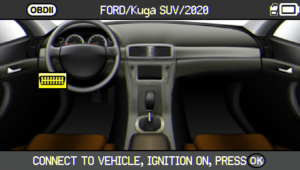Volver a todas las noticias
13.03.2020
EMEA TPMS diagnostic tips on FORD KUGA (2014-2020)
The European regulation no. 661/2009 of 13 July 2009 and its official application on November 1, 2014 obliges all vehicles manufactured in Europe to be equiped with a direct or indirect TPMS systems warning the driver, inside the vehicle, of any loss of tyre pressure, which is conducive to optimum fuel consumption and road safety” (chap. II, art. 9).
FORD KUGA

The Ford Kuga (2014-2020) uses a direct TPMS system, which means TPMS sensors are installed in the wheel. If one or more tires indicate low tire pressure, the TPMS sensors will transfer the information to the vehicle’s ECU. An indicator light (low-line TPMS system) or each tire pressure will show on the dash (high-line TPMS system).
When a sensor is replaced for one or more wheels of a Ford Kuga, a TPMS relearn is recommended to transfer the new TPMS sensor IDs to the vehicle’s ECU.
Type of TPMS System – Direct TPMS System
TPMS Sensors are installed in the wheel, tire pressure is communicated via radio frequency (RF) technology from the sensor to the vehicle’s ECU.
Type of TPMS frequency
433 MHz
OE and Aftermarket (Universal, Hybrid, Programmable, Configurable, One-to-One, OE-style) options for TPMS sensor replacement
All OE and Aftermarket programmable, configurable, hybrid and OE-type (one-to-one) TPMS sensor options and service kits can be found in the VT56 TPMS Tools and most Powered by ATEQ tools.
Type of TPMS tool required for TPMS light OFF
TPMS activation tool such as VT15, VT36, VT46 or VT56 for manual relearn.
VT56 and VT46 TPMS SCAN TOOL with OBDII module includes Sync ID technology for software versions DA1-32-12 and higher for bonus OBD relearn.
FORD KUGA MANUAL RELEARN PROCEDURE
![]() 1/12 – Set tyre pressure
1/12 – Set tyre pressure
2/12 – Engage Parking Brake
3/12 – Turn the ignition to OFF position then press and release the brake pedal
4/12 – Quickly turn the ignition from OFF to RUN (engine OFF) 3 times (stop in RUN position)
5/12 – Press and release the brake pedal
6/12 – Set the ignition to OFF
7/12 – Quickly turn the ignition from OFF to RUN (engine OFF) 3 times (stop in RUN position)
NOTE: All the above needs to be performed within 10 sec.
8/12 – The horn will sound once
9/12 – If equipped with message centre, TRAIN LF tyre appears
10/12 – Read Left Front sensor ID’s. A single horn sounds
11/12 – Repeat step for Front Right, Rear Right and Left Rear tyres
12/12 – TRAINING MODE COMPLETE is displayedIf the vehicle is not equipped with the message centre display, successful completion can be verified by turning the ignition OFF and not hearing the horn sound
Auto relearn procedure (years 2014-2020):
Confirm TPM sensors are properly installed
Adjust tire pressures to placard value
Drive vehicle for up to 20 minutes about 15 MPH or until TPMS light is off
FORD KUGA OBD RELEARN PROCEDURE
![]()

1/8 – Set tyre pressure
2/8 – Read all sensor IDs
3/8 – Turn ignition ON (engine off) or by pushing rapidly twice on ON/START (With remote keyless entry)
4/8 – Connect the OBDII Cable/Module to OBD connector
5/8 – Follow the screen’s instructions to reset the ECU
6/8 – The horn will sound once to confirm the relearn mode is active
7/8 – The horn sounds twice
8/8 -Turn ignition to OFF then ON (engine off)NOTICE: If the TPM Procedure failed, Turn ignition to OFF then ON (engine off) before retrying it again
LEARN HOW TO PROCEED AN OBD RELEARN ON A FORD KUGA

TROUBLESHOOTING TIPS
TPMS light stays “solid” after driving and successful transfer
1. Pressure incorrect – Ensure tire pressure matches vehicle spec with
inflator. Compare reading bytriggering sensors.
2. Temperature incorrect – Trigger sensors to verify temperature.
TPMS light “flashing” after driving and successful transfer
1. Sensor BAT LOW – Trigger sensor and check battery status.
2. Bad accelerometer – Replace sensor.
3. Defective sensor – Some non-OE sensors will cause the TPMS light to flash even after successful transfer. Replace with OE compatible sensor.
Letters “TPMS” on the dashboard are lit
1. DTC stored in memory – Read and clear.
Sensor not detected
1. Tool position snap & clamp in sensors
Position tool antenna parallel to the ground, above the valve stem, touching the tire side wall.
2. Tool position banded sensors
If properly installed, sensor should be 180° from the valve stem. Place tool on the sidewall at this location. If not, check every 90°.
3. Wrong sensor for the vehicle
Check sensor part number, compare withpart number in the tool or call support.
4. Defective sensor
Replace sensor.
5. Indirect TPMS system
Indirect TPMS doesn’t use sensors (check relearn procedure).
OBDII connection failure
1. OBDII module not required
Check relearn procedure, vehicle may not require an OBDII relearn.
2. Ignition is not in on position
Make sure ignition is in ON position, engine off.
3. Sensor not triggered
Ensure all 4 or 5 sensors are triggered.
4. OBDII transfer failure
Tool must recognize the OBDII module. LED on module should be flashing green.
5. Vehicle battery low
Check the voltage of the battery.
6. OBDI connection failure
Poor connection between OBDII module and OBDII connector. Damaged pins on OBDII module. Damaged OBDII connector.
7. TOYOTA/ LEXUS
Set TPMS Switch to MAIN position.
8. LEXUS/SCION/TOYOTA ECU reset button
TPMS reset button was pressed before registering new sensor ID (Use tool ECU unlock feature)
Contact us ATEQ TPMS Tools Europe – https://www.ateq-tpms.com/en-uk/home/contact/
Follow us on SOCIAL MEDIA #ATEQ TPMS Tools Europe
ATEQ TPMS releases Sync-ID, increasing OBD relearn c...
Relearn procedures differ from manufacturer to manuf...